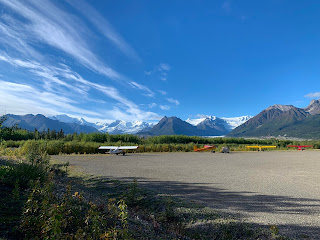We just returned from a successful Operation IceBridge mission. This is a NASA sponsored program to measure many of Alaska's glaciers annually. The main goal are repeat measurements of the surface with a Lidar to document the loss of ice in Alaska. But we also operate a radar to measure ice thickness, which is really challenging in the wet ice that doesn't lend itself to radar wave penetration and because of the very mountainous terrain that reflects a lot of radar waves and obscures the signal from the bottom of the glacier.
One particular treat of these survey flights is that we get to see parts of Alaska's mountains that are generally very difficult to reach and that are quite remote. I'll post some pictures in the next several posts. This first one here is about lakes.
Glaciers have the odd tendency to dig themselves into holes, so when they retreat they often leave depressions that are then filled with water to create glacial lakes. Because so many glaciers are retreating, proglacial lakes are very common in Alaska, and they are rapidly expanding. Here are some examples. I'll try to add some links to Google Maps, and for many areas you can easily see the growing lakes by looking through satellite imagery in Google Earth, for example.
This glacier near Seward has been retreating really rapidly (see also AGU's
From A Glacier's Perspective blog) and forming a large lake in the process. The iceberg in the picture is quite impressive in size.
The Allen Glacier is located in the Copper River Valley. The Miles Glacier is just visible in the distance (on the left). It also has a large lake. The Copper River Railroad went down this valley to bring the copper ore from Kennecott to the port of Cordova. It was abandoned in the late 1930s. The spur is still visible in the picture. At the time the Allen Glacier was much more advanced and the railroad tracks were actually laid across the debris covered ice of this glacier and had to be frequently maintained.
According to Wikipedia, Nabesna Glacier is the 'longest interior valley glacier on the planet'. I haven't tried to fact-check this, but it is a long glacier... As many of its friends, it is rapidly losing mass and building a big lake. There are large portions of floating ice that are ready to break off soon.
These glaciers are located in a phenomenal setting, where Mt. Fairweather rises 15,000 ft (4,500 m) straight from sea level. Both have been retreating rapidly forming big lakes.
This view is from Alsek Lake onto the Grand Plateau Glacier:
Alsek Glacier
A side branch of the Grand Plateau, creating its own lake
Terminus of Grand Plateau into Alsek Lake
I have written about
Yakutat Glacier before, since we had an NSF funded project there. This glacier is essentially doomed, since it really doesn't have any accumulation area left and it is subject to a positive feedback as the average elevation gets lower over time. The lake area in this picture was almost entirely ice covered just a few years ago.























































